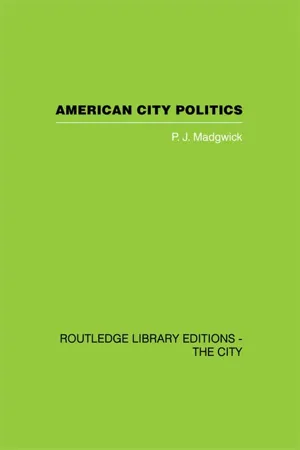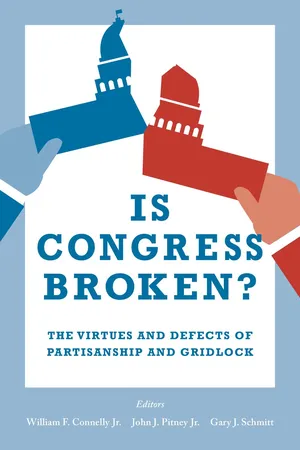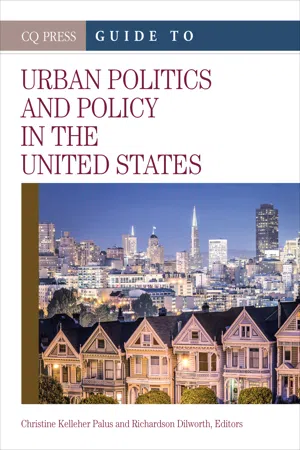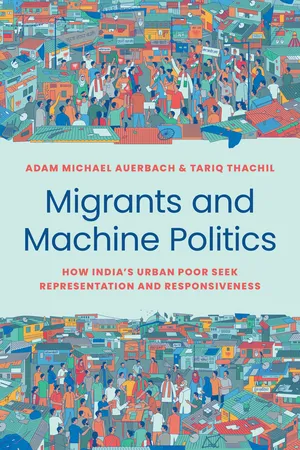History
Machine Politics
Machine politics refers to a system of political organization characterized by strong party control over local government, often involving corruption and patronage. This term is commonly associated with the late 19th and early 20th centuries in the United States, particularly in urban areas where political machines wielded significant influence through the distribution of jobs and services in exchange for political support.
Written by Perlego with AI-assistance
Related key terms
5 Key excerpts on "Machine Politics"
- eBook - ePub
Corrupt Illinois
Patronage, Cronyism, and Criminality
- Thomas J. Gradel, Dick Simpson(Authors)
- 2015(Publication Date)
- University of Illinois Press(Publisher)
Figure 2.1 Richard J. Daley Machine.Source: Created by Dick Simpson, based on course lectures by Milton Rakove.If you worked your precinct, you got a job at city hall or with other governments. If you voted for the machine, you got more government services delivered as favors than your neighbors. If as a businessman you gave money to fund campaigns, you got crooked contracts on which you made a handsome profit. So Machine Politics was primarily an economic exchange system—a perpetual-motion machine that didn’t depend on ideals or personalities, although party leaders could be charismatic and inspire loyal supporters.Milton Rakove, in his classic book on Machine Politics, Don’t Make No Waves, Don’t Back No Losers , describes Machine Politics this way:The machine believes with Machiavelli that men in politics are greedy, emotional, and passionate, and are not governed by reason, morality, or concern for their fellow man. It believes that men can be co-opted, bought, persuaded, or frightened into subservience to or cooperation with the machine. Every man has his price, according to the machine. . . . The Chicago Democratic machine is dedicated primarily to gaining and retaining office. . . . Its primary demands on its members are loyalty and political efficiency. In return, it carries out its obligations by providing its members with jobs, contracts, and its own “social security” system.4A successful political machine stays in power for a long time. While it may occasionally lose an election, it projects an aura of invincibility. It is able to use the powers of incumbency and control of the electoral machinery to stay in power. New York’s Tammany Hall party boss George Washington Plunkitt declared that reformers were only “morning glories” who had a brief bloom, but a political machine is like a giant oak that lasts a long time.5It is the central thesis of our book that the individualistic culture of much of Illinois is translated into the institution of political-party machines. Control of the many governments throughout the state by political machines inevitably leads to a corrupt political culture in which corruption and the use of public office for private gain becomes accepted and pervasive. - eBook - ePub
- Peter Madgwick(Author)
- 2012(Publication Date)
- Routledge(Publisher)
However when all the explanations for the decline of the machine have been reviewed, the fact remains that machines still operate. American society is no longer so responsive to the rewards and controls of the machine boss. But the politics of jobs and rewards, advice and welfare still obtain in some cities especially where there is a large low-income population (see Frost, 1961 and Watson,1963,22) City machines reappear after years of quiescence. Even Tammany Hall, no longer an actual building, continues to operate, though as a neighbourhood rather than a city-wide force. Party organizations still function, and the city machine is part of a state and national party organization. Parties still need money and support; and its clients still want rewards and services. The style of politics persists, though the organization has been changed by the great secular movements of society and politics–the waning of immigration and the coming and passing of the New Deal.Machine Politics appraised
Boss rule plainly had major defects. Its basic method led to corruption and inefficiency. It was concerned only with maintaining itself, and was indifferent to politics in the sense of policies for problem-solving and community development and the public agitation of issues. Spontaneous political organization was discouraged (see Gosnell, 1968, 83-4) and reformist tendencies were heresy. A New York reform leader once naively asked for posters for the Stevenson campaign (after all this was the Democratic Party?); ‘those political hacks … took me aside and told me that our man was Dan Fink, who was running for judge of the municipal court …’ (quoted in Wilson, 1962, 61). Boss rule excluded the possibility of dynamic politics and an extended scope for city government.Yet, there is a good deal on the credit side. ‘From the standpoint of politics the great mass of the people are interested in only three things: food, clothing and shelter’ (Martin Lomasney quoted in Curley, 1957, 157). These the machine endeavoured to provide, deriving some satisfaction from Steffens’ description of boss-ridden Philadelphia as corrupt but contented. The gains were not limited to the material. The machine was a medium of communication well suited to the needs of the immigrants and the poor: ‘the only true means that we have yet developed to communicate to the seats of the mighty in government the sentiments of the great mass of citizens and individuals … and to give these sentiments a genuine role in the formulation of policy’ (Reichley, 1959, 107).Thus the machine related power to the people, it helped to incorporate new groups into the polity. It took society as it was, provided for its needs, harmonized its pressures and created a community. Politically the machine brought together the power by which the conflicts of a decentralized system could be managed, and a socially explosive situation defused. In Chicago, for example, ‘when the Mayor ceases to be a boss, he will not have the power to run the city as it should be run* (Banfield, 1961, 258). Further, and through no deliberate effort on its own part, the machine produced a counter-movement, a reformist opposition, and thus brought about, sporadically it is true, a competitive form of urban politics. - eBook - ePub
Is Congress Broken?
The Virtues and Defects of Partisanship and Gridlock
- William F. Connelly, John Pitney, Gary J. Schmitt(Authors)
- 2017(Publication Date)
- Brookings Institution Press(Publisher)
Some thinkers emphasize the importance of parties, others the dynamics of negotiations, still others the impracticality of campaign finance rules. Without denigrating any of those viewpoints, I want to make the case for a realist emphasis on Machine Politics. Here, to me, is a distinctive, important, and greatly underappreciated realist proposition: For governments to govern, political machines or something like them need to exist, and they need to work. By “govern,” I mean reliably and reasonably reach accommodations on the problems and conflicts that demand resolution from day to day. By “political machines,” I mean informal (as opposed to legally constituted) and mutually accountable hierarchies, networks, and relationships that allow politicians to organize their environment by reaching and honoring accommodations, rewarding and protecting supporters, punishing and marginalizing defectors, and exerting coordinated influence through multiple formal channels. By “or something like them,” I mean to indicate that the famed big-city party machines of yesteryear are merely one kind of machine and that other, less sharply defined political organizations or networks can do the work of machines: for example, the “regular order” system in Congress, with its hierarchy of committees and seniority rules. Until the 1990s, the U.S. House of Representatives had a pronounced machine-like aspect, with minority Republicans claiming a piece of the appropriations action in exchange for cooperation with majority Democrats (an arrangement gleefully demolished by Newt Gingrich) - Christine Kelleher Palus, Richardson Dilworth(Authors)
- 2016(Publication Date)
- CQ Press(Publisher)
All these policy developments unfolded amid competition from various interests in the city, as well as within the context of an ongoing argument about how urban politics and policymaking should work. While some municipal reformers sought to centralize power in the hands of mayors, commissions, or managers and tighten purse strings, party operatives sought to distribute governmental largess more widely in order to cobble together electoral coalitions. The expansion of public welfare services gave politicians a new set of tools to win votes. Astute bosses learned to manage the distribution of collective benefits in ways that earned them credit with voters even as the supply of patronage and other divisible benefits diminished. They also took advantage of the centralization produced by municipal reform to consolidate power at city hall. Not surprisingly, the twentieth century saw the emergence of more citywide political machines than there had been in the nineteenth century. The construction during the 1930s of Chicago’s legendary Democratic machine out of that city’s notoriously fractious ward politics epitomizes this process.Urban governance in the early twentieth century was far from perfect. Shaped by partisan imperatives, increasingly active municipal governments distributed services and benefits to those best connected to the centers of power. At least in the short run, new immigrants, African Americans, and poor, unskilled workers generally received fewer benefits and had less influence than well-connected ethnic groups such as the Irish, businessmen, and skilled workers. The hope of municipal reformers that urban governance could be molded to serve a clearly defined, widely shared understanding of the common good foundered on the rocks of big-city heterogeneity. A few of the more thoughtful reformers looked for ways to integrate the conflicting groups and diverse interests at play in urban society, but their efforts failed to gain hoped-for traction. Machines and bosses continued to influence the operation of larger, more active municipal governments well into the twentieth century.NOTES1. Portions of this chapter draw upon Alan Lessoff and James J. Connolly, “From Political Insult to Political Theory: The Boss, the Machine, and the Pluralist City,” Journal of Policy History 25 (2013), 139–172.2. Quoted in Jon Teaford, The Unheralded Triumph: City Government in America (Baltimore: Johns Hopkins University Press, 1984), 1.3. Alexander B. Callow, The Tweed Ring (New York: Oxford University Press, 1965), 253–278.4. Steven P. Erie, Rainbow’s End: Irish-Americans and the Dilemmas of Urban Machine Politics, 1840–1985 (Berkeley: University of California Press, 1990), 51.5. Richard Croker, “Tammany Hall and the New Democracy,” North American Review 154 (February 1892), 225–230.6. Chicago Tribune, Aug. 30, 1877.7. James Bryce, The American Commonwealth, 3rd ed. (London: Macmillan, 1899), 2:75.8. Puck- eBook - ePub
Princeton Studies in Political Behavior
How India's Urban Poor Seek Representation and Responsiveness
- Adam Michael Auerbach, Tariq Thachil(Authors)
- 2023(Publication Date)
- Princeton University Press(Publisher)
Tulsi Nagar’s party workers illustrate one important and historically common pathway of inclusion through party machines. A venerable literature documents such machines as marked by three distinctive features. The first is their hierarchical, pyramid-shaped structures that link political elites (“patrons”) to voters who support them (“clients”). These linkages are typically facilitated by intermediaries (“brokers”) like Rajesh, who are entrenched in neighborhoods and forge face-to-face ties with voters. 18 Second, machines are arranged geographically, with brokers controlling neighborhoods that are nested within the larger electoral domains of their patrons. 19 Third, machines rely on the distribution of material spoils to win support—not lofty ideologies or policy promises. 20 These benefits can range from jobs, electricity connections, and access to hospital beds; to election-time handouts of cash and food; to local public goods like paved roads, sewers, and schools. Many of the earliest examples of party machines come from cities of the United States, particularly during a period stretching from the Gilded Age (the last quarter of the nineteenth century) through the Second World War. From New York and Philadelphia to Kansas City and Chicago, machine bosses generated electoral support among poor European migrants by doling out jobs and public services
Index pages curate the most relevant extracts from our library of academic textbooks. They’ve been created using an in-house natural language model (NLM), each adding context and meaning to key research topics.




